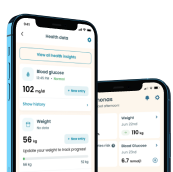Menopause and Diabetes

Menopause comes with some big changes. When people think of menopausal symptoms, they probably imagine unpleasant side effects like mood swings, night sweats, vaginal dryness, sleep disturbances, and hot flashes. Beyond these side effects, research shows that women tend to experience weight gain during the transition to menopause. Because of weight gain and other changes that occur during this time of life, menopause and diabetes can also go hand-in-hand, but there are ways to manage menopause symptoms to prevent progression to type 2 diabetes.
Prevalence of Menopause and Diabetes
There is evidence that women undergoing menopause are at higher risk of health issues like diabetes. So, just how common is the co-occurrence of menopause and diabetes? It is difficult to pinpoint an exact prevalence, but research suggests that diabetes during menopause is linked to a condition called metabolic syndrome, which involves the development of abdominal obesity (excess belly fat), high cholesterol, high blood pressure, and insulin resistance. Severe cases of metabolic syndrome can lead to increased blood sugar levels and the occurrence of diabetes in menopausal women.
In a recent study involving over 8,000 women, doctors found that the prevalence of type 2 diabetes was about 13% in women of menopausal age. In particular, being postmenopausal and experiencing conditions including high blood pressure and high triglycerides was linked to diabetes during menopause. This suggests that postmenopausal women are more likely to experience type 2 diabetes than women just starting the menopause transition.
Research findings are somewhat mixed, but in totality, they suggest that weight gain during menopause can alter the body’s insulin sensitivity and glucose metabolism, increasing the risk of developing diabetes. Combined with the elevated risk of metabolic syndrome during menopause, the body may become more insulin resistant, which can increase blood glucose levels and lead to increased diabetes risk.
Hormonal Changes Linked to Menopause and Diabetes
Increases in body weight, and more specifically body fat, can occur during menopause, leading to increased risk of both metabolic syndrome and diabetes. It turns out that hormonal changes during this time of life may be to blame for all of this. Unfortunately, changes in hormones can cause both physical and emotional symptoms, as women may have difficulty coping with the changes in body weight that occur during this time. For this reason, hormone therapy has been identified as a potential solution for diabetes prevention and for other issues that arise during menopause.
There is some evidence that hormone replacement therapy can reduce the accumulation of belly fat and therefore lower the risk of diabetes and other weight-related problems like cardiovascular disease. While there are some benefits associated with hormone replacement therapy, experts do not recommend this form of treatment to reduce diabetes risk, as it can elevate the risk of stroke. If you’re looking for a way to manage menopausal symptoms, including weight gain, you may consider talking with your doctor about whether hormone replacement therapy is a suitable option for you, given your family history and risk factors.
Preventing Diabetes Through Exercise

Diabetes may be more likely during the menopausal years, but living a healthy lifestyle can reduce your risk. Incorporating regular physical activity into your routine can promote weight loss and keep blood sugars under control, resulting in reduced diabetes risk. A recent study found that high-intensity interval training increased muscle mass and reduced body fat among menopausal women. This type of training was also found to increase insulin sensitivity, which can help women to manage blood sugar.
High-intensity interval training involves alternating periods of intense exercise, such as sprinting, with recovery periods of lower intensity. For example, a 20-minute high-intensity interval workout may begin with 5 minutes of walking to warm up and end with a 5-minute walking cool-down. During the middle 10 minutes, you might alternate one minute of running at maximum effort with one minute of walking to recover.
Adding some weights to your exercise regimen can also assist with keeping blood glucose levels in check. A second study found that when postmenopausal women with type 2 diabetes completed a combination of aerobic exercise and resistance training, they lost both weight and body fat after 12 weeks. This exercise program also increased muscle mass among the women in the study, which in turn reduced insulin resistance. A quality exercise program not only lowers diabetes risk by reducing body fat and insulin resistance; it can also prevent diabetes complications.
In summary, you can reduce your risk of diabetes during menopause by losing weight. Based upon several studies, older women can lose weight and improve their health by engaging in a combination of aerobic exercise and weight training. If you are unsure of how to begin an exercise program, it may be helpful to work with a personal trainer. As always, consult with your doctor before beginning a new exercise program.
Preventing Diabetes with a Healthy Diet
While physical activity can reduce blood sugar readings and prevent diabetes during menopause, a healthy diet is also important to help you manage menopause risks. While everyone’s dietary needs will vary slightly, large clinical trials provide information about what types of eating plans are generally effective for reducing the risk of diabetes. For example, one study found that high-fiber, low-fat diets were effective for weight loss, and they reduced the risk of diabetes among overweight middle-aged adults experiencing difficulty with glucose homeostasis. Additional research has shown that the consumption of whole grain products reduces the risk of diabetes.



Based upon research findings and medical knowledge, experts recommend making lifestyle changes and incorporating the following foods into the diet to prevent diabetes:
- Plenty of fruits
- Non-starchy vegetables, including peppers, broccoli, and spinach
- Whole grains such as quinoa and brown rice
- Low fat dairy like yogurt
- Lean proteins, including tofu, fish, eggs, and chicken
At the same time, processed foods, including sweets, potato chips, and fast food should be limited among those trying to reduce the risk of type 2 diabetes. Sugary drinks, packaged baked goods, and fried foods are also poor choices, as they can lead to weight gain and high blood sugar.
What Do I Do If I Develop Diabetes During Menopause?
While lifestyle changes can help you to reduce the risks that come along with hormone changes and weight gain during and after menopause, some women will develop type 2 diabetes during this time of life. Perhaps they have a family history of the disease, or they live with a health condition that makes it difficult to manage risk factors through exercise or other methods.
In this case, there are things that can be done to manage type 2 diabetes. If you develop the condition during menopause, your doctor will work with you to help you create a healthy eating plan that manages blood sugar levels and assists with disease control. Fortunately, a healthy diet can reduce risks associated with both diabetes and heart disease, so the silver lining is that the required lifestyle changes that come along with diabetes management can improve your health in other ways.
Women with diabetes will work with their medical provider to develop a treatment plan. Your doctor may refer you to a nutritionist to help you devise a diabetes diet that meets your needs. If you are physically able and your doctor clears you for exercise, you might also begin a workout routine. Sometimes, it can be as simple as taking a walk a few evenings a week after dinner. Or, you might enjoy exploring yoga classes or a group aerobics class if this is your preference. The truth is that any kind of physical exercise is helpful, and you can find something that is safe for you and sparks your interests.
In addition to diet and exercise changes, your doctor may prescribe medications, including insulin, to help you manage your blood glucose levels. You will have regular appointments with your doctor to ensure that your diabetes management plan is working for you. At home, you will need to follow your diabetes diet and check your blood glucose levels to ensure they stay within your target range.
Some women with diabetes worry that they will not be able to enjoy life when they live with this health condition. They might be worried they will have to give up eating out with friends, or eat foods that they do not enjoy. The truth is that many women with diabetes still enjoy the foods they love. You may have to make some alterations, such as using sugar-free versions of your favorite foods, but there are plenty of tasty diabetes recipes that make it easy to stick to a healthy eating plan.
Eating For Type 2 Diabetes

If you are among the postmenopausal women who live with type 2 diabetes, you will likely have to change the way you eat, but it doesn’t mean giving up everything you love. Your doctor will refer you to a nutritionist to help you learn healthy ways of eating for type 2 diabetes, but there is no single diet that works for everyone. Your nutritionist will help you develop an eating plan that meets your unique needs.
While everyone’s nutritional needs will vary, the Center for Disease Control and Prevention provides the following general dietary guidelines for those with type 2 diabetes:
- Limit added sugars and refined grains like white pasta and bread.
- Consume more non-starchy vegetables like broccoli and spinach
- Incorporate mostly whole foods, rather than processed foods, into the diet
- Eat balanced meals and include protein and fiber when consuming carbohydrates
- Choose fresh fruit in favor of fruit juice
- Be conscious of portion sizes
Given these guidelines, there are plenty of appealing meals you can make to promote your health and manage type 2 diabetes. For example, at a restaurant, you might order a grilled chicken salad and ask for the dressing on the side. You can also prepare this meal at home and use a dressing with no-added sugars. A meal such as grilled chicken fajitas, served with a low carb wrap, or with no wrap, is also a suitable option. There are many more diabetes recipes that promote good health, but these are just some examples.
The Bottom Line: Managing Diabetes Risk During Menopause
A combination of a regular exercise routine an an appropriate diet can help you lose weight and manage diabetes, even in the face of menopause symptoms. Learning that you have a diabetes diagnosis isn’t easy, but the truth is that you can still lead a healthy, productive life. It may be challenging to make significant changes to your habits, but in the end, these changes will improve your health.
Even if you haven’t developed diabetes, keep in mind that the risk of this and other health problems increases later in life. For instance, heart disease risk increases during menopause, largely because the body makes less estrogen. Hormone therapy may be an option for treating low postmenopausal estrogen levels, but a healthy lifestyle is also effective. Fortunately, the same healthy choices that protect you from diabetes (nutritious diet and regular exercise) can ward off heart disease. If you’re undergoing menopausal symptoms like vaginal infections, hot flushes, and urinary tract infections, now is the time to make some positive changes to keep yourself as healthy as possible.
Take a quiz and get your diabetes-management plan today!









